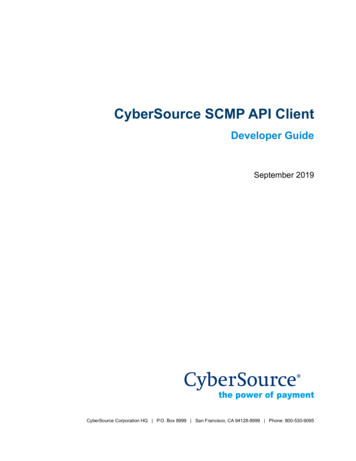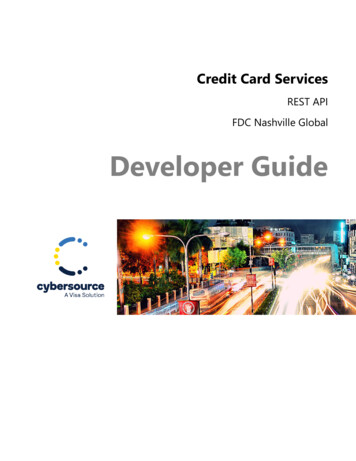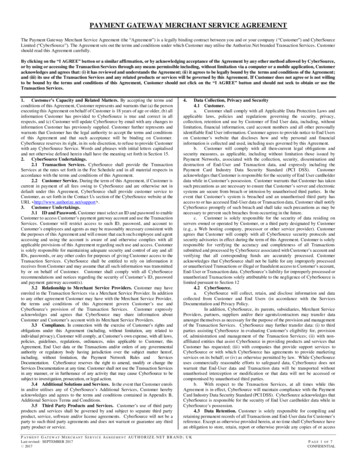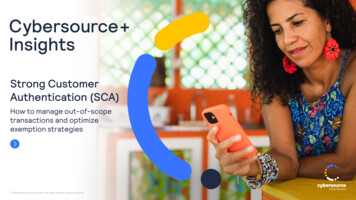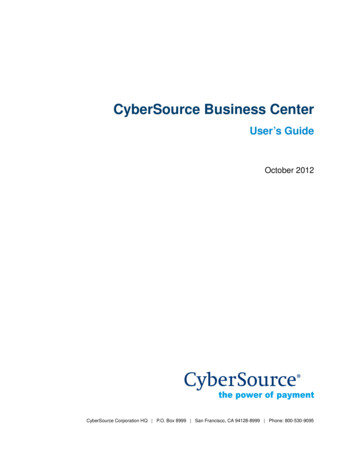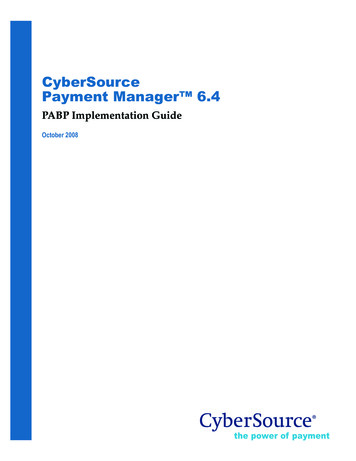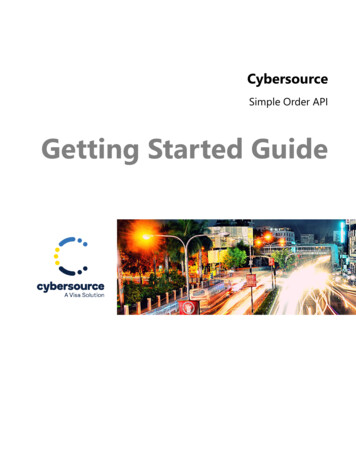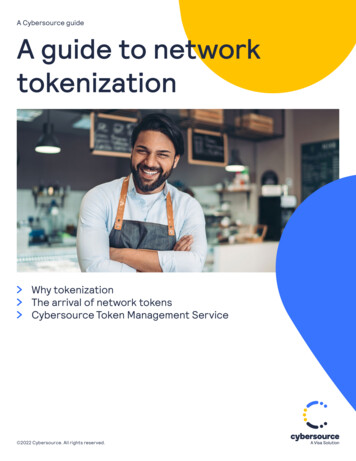
Transcription
Cybersource ExpertsBuilding fraud strategiesthat get more business inHow to stay ahead in a world of change 2020 Cybersource Corporation. All rights reserved cybersource.com
ContentsIntroductionMeet our expertsFraud landscapeoverviewBuild a fraud strategy thathelps capture more revenueGear your business upfor the futureBringing it alltogetherHow Cybersourcecan helpContentsIntroduction.3Meet our experts.4Fraud landscape overview.5 How has the pandemic changed fraud? How have businesses responded? The role of machine learning in fraud detection Spotlight on account takeover and loyalty fraudBuild a fraud strategy that helps capture more revenue. 14 Know your genuine customers Help your customers buy what they need The next step: optimize authorizationGear your business up for the future. 20 Optimize for PSD2 SCA Evolving role of a fraud managerBringing it all together.26How Cybersource can help. 27 2020 Cybersource Corporation. All rights reserved cybersource.com2
ContentsIntroductionMeet our expertsFraud landscapeoverviewBuild a fraud strategy thathelps capture more revenueGear your business upfor the futureBringing it alltogetherHow Cybersourcecan helpIn a world of changeadaptability is everythingAs the COVID-19 pandemic caused a surge in online shopping and some truly innovativebusiness responses, fraudsters too looked for ways to adapt their behavior.We’ve got you covered. To help prepare for what’s next, we brought together a team ofspecialists from the Merchant Risk Council (MRC), Decoded and Cybersource to sharetheir insights, and help you jumpstart your fraud strategy.Read on to learn:1. How merchants haveresponded to thechanging fraudlandscape2. The top prioritiesfor fraud teams aswe gear up for thefuture 2020 Cybersource Corporation. All rights reserved cybersource.com3. H ow you can build afraud strategy thatnot only stops badorders, but helps getmore business in3
ContentsMeet our expertsIntroductionFraud landscapeoverviewBuild a fraud strategy thathelps capture more revenueGear your business upfor the futureBringing it alltogetherHow Cybersourcecan helpMeet our expertsUna DillonChris MonkAndrew NaumannMari-anne BaylissMark StrachanManaging Director, Europe,Merchant Risk Council (MRC)Director of Business Operations,DecodedVice President, ProductManagement, CybersourceSenior Director, Europe RegionalSolutions, CybersourceDirector, Global Services,CybersourceUna’s role at the MRC gives herunique insight into merchants’challenges and priorities in theevolving world of eCommerce.Her extensive experienceincludes payment regulation,fraud prevention and financialservices strategy.Chris combines a passion fortechnology, software development,cybersecurity, data science and theinternet of things with a zeal toeducate. He’s responsible for thedelivery of Decoded’s executivetechnology education services inEMEA and APAC.Andrew is responsible for the visionand strategy for Cybersource fraudmanagement solutions. As well asproduct managers and decisionscientists, his cross-functional teamincludes risk analysts who developfraud strategies for key clients.Mari-anne works with merchantsin Europe to understand regionaltrends and ensure they’rereflected in product development.She brings 20 years’ experience infraud prevention at a large UKretailer to her current role.Mark is a fraud risk professional withover 12 years’ experience in thepayment and banking industry.He works with merchants in sectorssuch as retail, digital and ticketing todevelop strategies to reduce riskassociated with fraudulent activity. 2020 Cybersource Corporation. All rights reserved cybersource.com4
ContentsIntroductionMeet our expertsFraud landscapeoverviewBuild a fraud strategy thathelps capture more revenueGear your business upfor the futureBringing it alltogetherHow Cybersourcecan helpWhen the world around you changes,you can’t afford to stand stillWe are operating in constant change. Customers alter their behavior and revisetheir expectations. Technology advances. New regulations come into force.Unpredictable external factors bring change too. Take the COVID-19 pandemic:lockdowns and government guidance caused a big shift to online shopping,encouraging a fair few consumers to buy online for the first time ever.As Chris Monk from Decoded puts it: “COVID-19 has done more for eCommerceadoption than any other single thing in the past 10 years.”COVID-19 drives a shift to eCommerce49%of consumers globally saythey’re shopping more onlinethan before COVID-191“ Keeping the balanceright between a goodfraud preventionstrategy and theconsumer experienceis always a challenge.”Una Dillon, MRC77%74%of UK consumers now doat least part of theirgrocery shop online2of people in the UK across all agegroups now feel comfortable buyingonline since the COVID-19 outbreak3Source: Bazaarvoice “Pandemics and presents: A look at how consumers plan to shop for the holidays in 2020”Source: Waitrose “How Britain Shops: Online Food and Drink Edition”3Source: Bazaarvoice “Behavior that sticks: Understanding the long-term shopping trends driven by COVID-19”12 2020 Cybersource Corporation. All rights reserved cybersource.com5
ContentsIntroductionMeet our expertsFraud landscapeoverviewBuild a fraud strategy thathelps capture more revenueGear your business upfor the futureBringing it alltogetherHow Cybersourcecan helpStores whose previous business was mainly or exclusivelyface-to-face had to embrace eCommerce very quickly. Setting upwebsites. Getting logistics operations in place. And implementingpayment platforms and fraud detection systems for card-notpresent (CNP) transactions.“The fraud rate for these merchants was likely to increase owingto their lack of experience and how fast they had to deploy.And there’s always going to be a higher rate of fraud with CNPtransactions than with point-of-sale (PoS) transactions,” saysMari-anne Bayliss from Cybersource.And as her colleague Mark Strachan points out, fraudsters aresmart and flexible: “They keep up to date with the evolvingeCommerce landscape and adapt their behavior, tools andtechniques accordingly.”“ Fraudsters will always customize theirattacks to make them relevant towhatever’s happening in the world.”Mark Strachan, Cybersource 2020 Cybersource Corporation. All rights reserved cybersource.com6
ContentsIntroductionMeet our expertsFraud landscapeoverviewBuild a fraud strategy thathelps capture more revenueGear your business upfor the futureBringing it alltogetherHow Cybersourcecan helpHow has the pandemicchanged fraud?Mark explains that the changes observed have been less aboutnew types of fraud, and more about fraudsters rapidly adaptingtheir practices to take advantage of the new situation. Fraudstershave, for example, carried out COVID-19–themed phishing andsmishing attacks to steal account credentials that can be resoldor used in account takeover and loyalty fraud attacks.And, as expected, they’ve moved quickly to exploit thepandemic-driven increase in online shopping. “It’s inevitablethat online fraud would increase because criminals will alwaysgo where the money is,” says Chris.The MRC’s Una Dillon picks up on the challenge this creates forbusinesses that haven’t traditionally had a strong eCommercechannel: “It’s been a huge change for a lot of merchants, especiallythose with physical stores as well as online channels, who’ve seena flood of new online customers. And while that sounds like a goodproblem to have, it makes things more difficult in terms of fraudprevention, as fraud teams are faced with fraudsters hiding inamong the good customers.” 2020 Cybersource Corporation. All rights reserved cybersource.comSome noticeable changes in fraudsters’ behavior have been:Taking advantage of contactless and other sociallydistanced delivery options (that don’t require acustomer signature) to commit fraudI ncreased buying of digital goods, such as eGiftcards, using stolen card details to avoid thelonger window for fraud screening associatedwith physical goodsMore account takeover andloyalty fraud attacks7
ContentsIntroductionMeet our expertsFraud landscapeoverviewBuild a fraud strategy thathelps capture more revenueGear your business upfor the futureBringing it alltogetherHow Cybersourcecan helpFriendly fraud — already ranked 5th out of the top 10 fraud attacks experienced4 — hasincreased. Una’s view: “I think that spending extended periods at home in front of theircomputer has led some people to make more impulse purchases online. They may thenexperience ‘buyer’s remorse’, or simply decide they don’t want the item anymore.”Friendly fraud — also known as chargeback fraud or first-party fraud — can also happenwhen a customer struggles to navigate a merchant’s returns and refund process, or a refundsimply takes too long.Whatever the reason behind friendly fraud, Mari-anne fromCybersource advises: “To deal well with friendly fraud meansspotting it fast and taking action. It’s a genuine customer doingsomething dishonest — there’s no sophisticated strategy behind it.”Mari-anne Bayliss, CybersourceWhat is friendly fraud?A customer makes a purchase online for a product or servicewith their payment card and then contacts their card issuerto dispute the charge. This type of fraud is often referred toas friendly fraud because the customer will make claims thatseem believable and honest.Source: Verifi.com 2020 Cybersource Corporation. All rights reserved cybersource.com4Source: Cybersource: Masters of Balance, 2019 Global eCommerce Fraud Management Report8
ContentsIntroductionMeet our expertsFraud landscapeoverviewBuild a fraud strategy thathelps capture more revenueGear your business upfor the futureBringing it alltogetherHow Cybersourcecan helpHow have businessesresponded?“Being adaptable involves keeping up with the latest fraud trends.Knowing what fraud is out there is the first step to preventing it,”says Una. “It’s good to broaden your outlook — speak with externalexperts, acquire intelligence from merchant groups, and buildnetworks to share knowledge.”Businesses should also use chargeback reports from card issuers,available from acquirers, to gain insight into transactions that havebeen reported as fraudulent. Understanding the reason for eachchargeback claim can help a business recognize risk more effectively.During the pandemic, we’ve seen merchants makerapid adjustments to their fraud strategies to:Avoid chargebacks and other issuesassociated with increased fraudAccept more genuine ordersMaintain a great shopping experiencefor genuine customers“ The pandemic has been a huge learning curvefor some merchants, and criminals will be awareof this. They will look for the weak spots.”Una Dillon, MRC 2020 Cybersource Corporation. All rights reserved cybersource.com9
ContentsIntroductionMeet our expertsFraud landscapeoverviewBuild a fraud strategy thathelps capture more revenueGear your business upfor the futureBringing it alltogetherHow Cybersourcecan helpThe role of machine learningin fraud detectionBusinesses need to use machine learning (ML) intelligently to enhanceboth the customer experience and their fraud strategy. Una points outthat merchants have access to huge amounts of data about consumerbehaviors, activity and velocity levels — all of which can be measured.“So why not use the tools? It just makes sense,” she says.Although ML is a powerful technology, it’s only as good as the data itconsumes and the human-set rules it works to. So it’s unlikely that a toolbased exclusively on ML could pick up quickly enough on the changes inconsumer and fraudster behavior caused by a situation like the pandemic.“A business that relies exclusively on ML in such a context couldexperience high rates of fraud and chargebacks, or low levels of customersatisfaction as too many good orders are rejected,” says Mark.“ The disadvantage of ML is thatit’s backward looking. Workingalone, it may not adapt as readilyas a human being who can quicklyunderstand a new context, such asCOVID-19, and react promptly tochanges in patterns.”Andrew Naumann, CybersourceInstead, businesses should consider using a fraud screening tool that’sbacked by experts who can help with fraud strategy creation andadaptation. As Mari-anne explains: “In any fast-changing time, you needhuman intervention to carry out day-to-day analysis of new trends.It’s never one thing alone that will solve the problem — you need totake a layered approach to fraud screening.” 2020 Cybersource Corporation. All rights reserved cybersource.com10
ContentsIntroductionMeet our expertsFraud landscapeoverviewBuild a fraud strategy thathelps capture more revenueGear your business upfor the futureBringing it alltogetherHow Cybersourcecan helpSpotlight on accounttakeover and loyalty fraudAccount takeover and loyalty fraud attacks typically start whenfraudsters steal account credentials in a data breach or a phishingor smishing attack. Counting on the fact that many people reusepasswords, a fraudster then uses those stolen credentials to tryto log in to customer accounts on other websites.Once logged in, the fraudster will steal or misuse whatever’sstored in the account: personal information, payment details,vouchers or loyalty points. Chris notes that loyalty points canbe extremely valuable: “Because I’ve traveled so much forwork, my airline loyalty account is probably worth more thanmy bank account!”“ People know that reusing passwords is a bad ideabut it doesn’t always stop them. Almost all ofus know someone who’s been a victim ofaccount takeover.”Chris Monk, DecodedThe global loyalty management market was valuedat USD 3.2 billion in 2019, and is expected toreach a value of USD 11.4 billion by 20255“Fraudsters will use loyalty points to buy high-value items likefirst-class flights or five-star hotel rooms, then sell them on,”says Una. “That’s why the Merchant Risk Council encourages itsmembers to treat their loyalty programs as they would cash.” 2020 Cybersource Corporation. All rights reserved cybersource.com5 Source: Loyalty Management Market — Growth, Trends and Forecasts (2020–2025).11
ContentsIntroductionMeet our expertsFraud landscapeoverviewBuild a fraud strategy thathelps capture more revenueGear your business upfor the futureBringing it alltogetherHow Cybersourcecan helpCustomers of an online business affected by account takeover or loyaltyfraud may lose trust in the brand and walk away from it. The business mayalso have to deal with financial losses, including customer refunds,chargeback fees and inventory loss. “As merchants look to rebuild businessand deal with the pandemic-driven recession that’s on the cards, these arerisks they’ll want to avoid,” says Mark.The most effective approach to preventing account takeover and loyaltyfraud involves monitoring account activity to detect and block fraudstersbefore they can carry out any transactions. From a behavioral point of view,automated login attempts using a credential stuffing tool — a feature ofmany account takeover attacks these days — look quite different from loginsby genuine account-holders.Using a specialized account takeover protection solution can help.“Your solution should be able to distinguish between genuine and fraudulentbehavior by monitoring account events — creation, login and update —for suspicious activity, and factoring in data relating to things like emailaddresses and devices used,” says Mari-anne.What is credential stuffing?Credential stuffing is the practice of using stolen login information fromone account to gain access to accounts on a number of sites throughautomated login. The exploit can allow hackers and those buying stolencredentials to access not just the accounts from the sites they arestolen from, but any account where the victim uses the same password.Source: WhatIs.com 2020 Cybersource Corporation. All rights reserved cybersource.com12
ContentsIntroductionMeet our expertsFraud landscapeoverviewBuild a fraud strategy thathelps capture more revenueGear your business upfor the futureBringing it alltogetherHow Cybersourcecan helpTop takeawaysIn times of rapid change, businesses need to:Keep up to date with evolving fraudster andcustomer behavior — gleaning intelligencefrom external as well as internal sourcesBe ready to adapt their fraud screeningtechniques accordinglyCombine machine learning with human insightto combat fraud more effectivelyConsider deploying a specialist tool to helpcombat account takeover and loyalty fraud 2020 Cybersource Corporation. All rights reserved cybersource.com13
ContentsIntroductionMeet our expertsFraud landscapeoverviewBuild a fraud strategy thathelps capture more revenueGear your business upfor the futureBringing it alltogetherHow Cybersourcecan helpBuild a fraud strategy thathelps capture more revenueThe impact of the pandemic on merchants’ revenues hasdepended to a large extent on what they sell. Vendors of essentialproducts and providers of streaming services have generallyseen revenues increase, and will want to maintain those levels.On the other hand, travel and tourism operators have beenamong the worst affected, and will want to restore revenuesas quickly as possible.“Either way, merchants will want to ensure their fraud strategy istuned to accept as many good orders as possible — without losingsight of the need to minimize fraud,” says Mark. 2020 Cybersource Corporation. All rights reserved cybersource.com“ We’re seeing merchants’preoccupation changefrom pure fraudmanagement to revenuecapture.”Andrew Naumann, Cybersource14
ContentsIntroductionMeet our expertsFraud landscapeoverviewBuild a fraud strategy thathelps capture more revenueGear your business upfor the futureBringing it alltogetherHow Cybersourcecan helpKnow your genuine customers.And treat them right.In the digital economy speed and convenience meaneverything. Businesses need to make a good impression onnew customers. And given that the shift to online shoppinglooks likely to be the ‘new normal’, merchants should dotheir best to capitalize on it. Ensuring a secure, frictionlesspayment experience for genuine customers is critical, soyou need to able to recognize them, as Andrew explains:“You have to take into account, for example, that if anorder has to be shipped within 24 hours, there’s limitedtime for manual review. Or if card details are stored incustomers’ accounts (also known as card on file), there’s arisk of account takeover and fraudulent purchases beingmade. It’s why the device fingerprint has become soimportant: a merchant has to know who the customeris all the time.”Advanced technology has a role to play here, withdifferent methods employed to create a uniquecustomer ID. 2020 Cybersource Corporation. All rights reserved cybersource.com“ Voice recognition, haptic recognition,typing habits all help to create a unique IDfor a customer — and get away from passwords.”Chris Monk, DecodedWhat is a device fingerprint?Device fingerprinting is a way to combine certain attributes of adevice — like what operating system it is on, the type and versionof web browser being used, the browser’s language setting and thedevice’s IP address — to identify it as a unique device.Source: Digiday.com15
ContentsIntroductionMeet our expertsFraud landscapeoverviewBuild a fraud strategy thathelps capture more revenueGear your business upfor the futureBringing it alltogetherHow Cybersourcecan helpKnow your genuine customers.And treat them right.(continued from previous page)Fraud detection and the customer experience are two sides of the samecoin, and each business will make its own decision about how to balancethem. But focusing only on stopping fraud could affect a lot of genuinecustomers by providing a less-than-great customer experience. To avoidthat pitfall, Mark advises merchants to treat good customers withdifferent rules than those used for suspicious-looking purchases.“You need to combine a high-quality detection system with knowledgeabout normal sales, and make a choice based on the numbers,” he says.“That involves using scoring models that take account of positivecustomer behavior in order to streamline the experience for genuinecustomers and make the fraudsters stand out.”For transactions that exceed a specified risk threshold, a business will needto add human insight — such as an understanding of the customer and localknowledge — to make decisions about how to deal with a risky order. 2020 Cybersource Corporation. All rights reserved cybersource.com16
ContentsIntroductionMeet our expertsFraud landscapeoverviewBuild a fraud strategy thathelps capture more revenueGear your business upfor the futureBringing it alltogetherHow Cybersourcecan helpHelp your customersbuy what they needEmbedding your fraud detection and prevention system at the core ofyour business decision-making can help you adjust — and enforce — yourbusiness policy to support good customer experience, especially in timesof turbulence. Andrew explains how Cybersource supported businessesdoing this during the pandemic by helping them make creative use oftools they already had:“We helped a supermarket to ration the volume of a given product toensure fair shares for all consumers. And we helped airlines acceptone-way bookings for repatriation flights — instead of treating them aspotentially fraudulent transactions — so that people could get back homewhen lockdowns and quarantines came into force.” 2020 Cybersource Corporation. All rights reserved cybersource.com17
ContentsIntroductionMeet our expertsFraud landscapeoverviewBuild a fraud strategy thathelps capture more revenueGear your business upfor the futureBringing it alltogetherHow Cybersourcecan helpThe next step:optimize authorizationVisaNet data shows that issuers declined 13.07% transactions globallyin the period of October 2019 to September 20206. This represents apotential loss of revenues for merchants as some of those declinedtransactions would have been good orders.To reduce the number of good orders being declined, merchantsshould look at how they can help issuers make more informed decisions.For example, if a merchant screens transactions for fraud before sendingthem, the issuers will receive better quality transactions that they’remore likely to accept.As Andrew explains: “Merchants actually have more data abouttransactions than issuers do. Sharing some of that data with issuerswill provide them with more information on which to base decisions.This is where EMV 3-D Secure can help.”“ Card issuers decline moreCNP transactions than in-store.So there’s an opportunity formerchants to close that gapand increase their revenues.That involves merchants boostingissuers’ confidence to authorizemore of those transactionsfor payment.”Andrew Naumann, CybersourceEMV 3-D Secure (EMV 3DS) allows a merchant to share10 x more data with the issuer (135 data elements intotal) compared with 3DS 1. 2020 Cybersource Corporation. All rights reserved cybersource.com6Source: VisaNet Global issuer decline rate in the period of 1 October 2019 to 30 September 202018
ContentsIntroductionMeet our expertsFraud landscapeoverviewBuild a fraud strategy thathelps capture more revenueGear your business upfor the futureBringing it alltogetherHow Cybersourcecan helpTop takeawaysTo build a fraud strategy to capture more revenue, businesses should:Focus on recognizing good customers andcreating a great shopping experience for themMake it easy for customers to buy the productsand services they needLook at recapturing lost revenue by enablingcard issuers to make more informed decisionsabout transactions 2020 Cybersource Corporation. All rights reserved cybersource.com19
ContentsIntroductionMeet our expertsFraud landscapeoverviewBuild a fraud strategy thathelps capture more revenueGear your business upfor the futureBringing it alltogetherHow Cybersourcecan helpGear your business up for the futureMerchants’ coming fraud management priorities will depend on the maturity oftheir current strategy.Understanding and combating fraud will be an ongoing concern, as will ensuringtheir operations are cost effective. But businesses shouldn’t allow their focus todrift from driving revenues and retaining good customers. “A fraud screening toollike Cybersource Decision Manager will help merchants get the balance right,especially in challenging times like these,” says Andrew.Data also has a critical role to play in a successful fraud strategy: “As well asinvesting in the right tools, merchants need access to the right data (and enoughof it). Your own data is good but the ability to see what’s happening elsewhere— and to learn from other merchants — will help you react faster to change,”advises Mari-anne.“ A fraud screening toollike CybersourceDecision Manager willhelp merchants get thebalance right, especiallyin challenging timeslike these.”Andrew Naumann, CybersourceMark suggests that businesses should ensure their business strategy is alignedto consumer buying patterns, their chargeback processing is effective, and thatthey continue investing in their fraud teams. “Throughout this challenging period,fraudsters will expect skeleton staffing and reduced budgets, and willtake advantage of merchants who don’t keep a close eye on fraud,” he warns. 2020 Cybersource Corporation. All rights reserved cybersource.com20
ContentsIntroductionMeet our expertsFraud landscapeoverviewBuild a fraud strategy thathelps capture more revenueGear your business upfor the futureBringing it alltogetherHow Cybersourcecan helpOptimize forPSD2 SCAPSD2 is the revised European Payment Services Directive.The associated strong customer authentication (SCA) requirementmeans that some payment transactions — when both issuer andacquirer are in the regulated area (European Economic area (EEA),UK and Gibraltar) — will need two-factor authentication. If the issuercan’t authenticate a transaction, it may be declined.Some transactions will be out of scope for SCA: Those in the mail order/telephone order (MOTO) channel Those initiated by merchants (such as direct debits) One-leg-out (OLO) transactions (when the issuer or acquirer isoutside of the regulated area) Recurring transactions with a consistent amount once the first onehas been authenticated“ The scale of change withSCA is big. Merchants needto familiarize themselveswith exemptions andout-of-scope transactions,and be ready to supportcompliance.”Mari-anne Bayliss, CybersourceAs well as increasing security for online payments, PSD2 SCA aims tooptimize the customer experience. That’s why some transactionsthat are in scope for SCA may be exempted from authentication byacquirers or issuers. One way they may make this decision is by usingtransaction risk analysis (TRA) on lower-value transactions. 2020 Cybersource Corporation. All rights reserved cybersource.com21
ContentsIntroductionMeet our expertsFraud landscapeoverviewBuild a fraud strategy thathelps capture more revenueGear your business upfor the futureBringing it alltogetherHow Cybersourcecan helpOptimize forPSD2 SCA(continued from previous page)“ If you don’t screen for fraud,you could expose your business to it. For one thing, you’ll need to protecttransactions that are out of scopefor SCA, which could become atarget for fraudsters once SCAcomes into force.”Mari-anne Bayliss, Cybersource“Merchants must do their best to identify in-scope transactions that may be exemptedfrom authentication,” says Andrew. “Although only acquirers and issuers can exempttransactions, merchants need to be in constant conversation with their acquirersabout possible exemptions, and about how to navigate the legislation and establishan SCA strategy.”Merchants will want to keep any perceived SCA friction for customers to a minimum.“This is why a move to EMV 3-D Secure is recommended. In particular, it will ensure abetter SCA experience on mobile devices — which is important as many people areshifting to shopping on their mobiles,” says Mari-anne.And if any merchants are wondering why they’ll need to continue screening for fraud onceSCA comes into force, Mari-anne has the answer: “If you don’t screen for fraud, you couldexpose your business to it. For one thing, you’ll need to protect transactions that are outof scope for SCA, which could become a target for fraudsters once SCA comes into force.”In addition, a business’s fraud rate will still be an important metric for acquirers andissuers, even when the business itself isn’t liable for fraud. And the card scheme ruleswill still require businesses to keep their fraud rates below a certain level.“Use of transaction risk analysis and decisions about exemptions will dependon the overall standing of acquirers and issuers, and each merchant’sfraud rate will affect the whole network,” says Mark. 2020 Cybersource Corporation. All rights reserved cybersource.com22
ContentsIntroductionMeet our expertsFraud landscapeoverviewBuild a fraud strategy thathelps capture more revenueGear your business upfor the futureBringing it alltogetherHow Cybersourcecan helpThe fraud manager’srole is evolvingThe
Management, Cybersource Andrew is responsible for the vision and strategy for Cybersource fraud management solutions. As well as product managers and decision scientists, his cross-functional team includes risk analysts who develop fraud strategies for key clients. Mari-anne Bayliss Senior Director, Europe Regional Solutions, Cybersource
